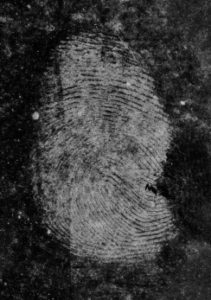
My about-to-be-released novel, Submerged Hopes, contains one very memorable handprint, but also an instance of the use of fingerprints, or dactyloscopy, during investigation of a crime. Here’s what I learned in my research.
Fingerprints are unique to the individual—even identical twins have different fingerprints. There are basic fingerprint patterns of friction ridges into loops, whorls, or arches, though it’s the tiny variances, called minutiae, which are used to identify a specific set of prints. Modern prints are categorized with a numerical calculation based on the presence of whorls on five fingers. Do other species have fingerprints? Yes—in fact, it’s said to be difficult to tell the difference between the fingerprints of a human and a koala, even with an electron microscope! Very rarely, people are born with a genetic defect that prevents their friction ridges from forming. Thus, people with adermatoglyphia do not have fingerprints.
The use of fingerprints for identification is age-old; the ancient Babylonians pressed fingers into clay to record business transactions, and the Chinese did the same with paper and ink. Fingerprints weren’t used to detect criminals until the 19th century, however. A police officer in Buenos Aires named Vucetich was the first to use them in a murder case in 1892, involving two young boys. Suspicion had fallen on the mother’s love interest, but the prints showed that the mother herself was guilty. Over time, the technique spread and databases grew. In the 1980s, the Japanese National Police Agency started AFIS, or Automated Fingerprint Identification Systems. It’s now IAFIS (integrated AFIS), which now allows law enforcement around the world to check fingerprints against millions on record almost instantaneously.
When I was getting my security clearance, the process was old-school: the technician rolled each of my fingers first in ink, then across a heavy paper to get an impression, and finally, had me do a “touch down” of all of them at the bottom of the record. These are called exemplar, or known, prints. Nowadays, a digital scanner does the job with less mess.
Fingerprints left on an object can be visible, or latent. The latter can’t be seen with the naked eye, but are composed of miniscule deposits of skin oils and cells. Plastic prints are impressions left in soft materials like soap.
The techniques for acquiring prints at a crime scene depends on whether the surfaces touched are porous or non-porous. The latter can be picked up by “dusting for prints” with a brush and fine powder, then “lifting” the prints with clear tape. However, the aqueous portion of a print may dry fast, making this technique less useful for older prints.
Criminals often try to wipe off their prints; a few have had their fingers burned or otherwise altered, like Alvin “Creepy” Karpis. The lack of prints doesn’t necessarily prove dirtbaggery, however. Sometimes, elderly people have fading prints because the skin thins with age.
Water has an adverse effect on fingerprint retention. The longer an item is submerged, and the higher the water temperatures, the more difficult it is to detect prints, and saltwater is worse than freshwater. The techniques used for detection are as follows: black powder, which uses carbon-based fine powders to cling to residues, SPR or small particle reagent, a suspension of molybdenum disulfide in detergent, which adheres to fatty residues forming a gray deposit, and CA, or cyanoacrylate (super glue) fuming, in which the vapors polymerize on the fingerprints. In the interest of accuracy, I researched dozens of articles, and the best one was in the Egyptian Journal of Forensic Sciences by Madkour, et al in 2017.
Madkour’s team had volunteers touch CDs, glass, and knife blades, before immersing the items in fresh and salt water tanks for various durations, then tested retrieval methods, scoring prints from 1-5 (no print, visibility ranging from bad to poor to good to very good). The CA technique was superior, and prints lasted longer on metal, disappearing fastest on plastic. Prints lasted longer in freshwater. Nonetheless, 60% of prints were still rated “good” after ten days in salt water!
Someday, I’ll have to write a story about an unstoppable criminal duo: an elderly woman and her nefarious trained koala sidekick!
Recent Comments